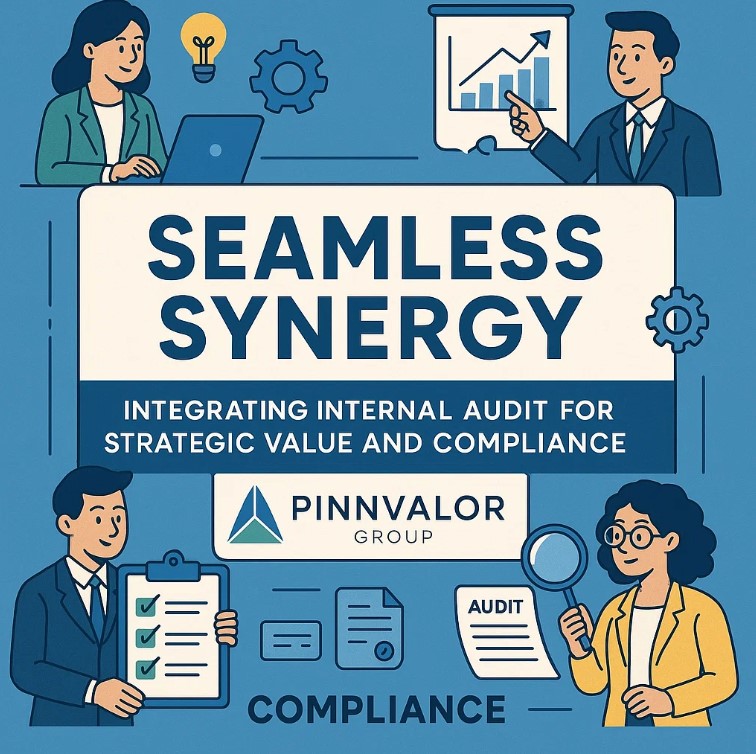
Seamless Synergy: Integrating Internal Audit for Strategic Value and Compliance
In today’s dynamic business environment, organizations are increasingly recognizing the importance of integrating internal audit functions into their strategic framework. Not only does this integration help ensure compliance and mitigate risks, but it also unlocks insights for enhanced performance and long-term value creation. This blog post outlines the core benefits of internal audit integration and offers a real-world case study to illustrate its practical impact.
Is your audit function a watchdog or a business enabler?
A truly integrated audit function doesn’t just find what’s wrong — it helps guide what’s right. It bridges compliance, strategy, and performance.
Understanding the Role of Internal Audit Integration
Integrating internal audit into the broader organizational strategy goes beyond a mere compliance checkpoint. It is a strategic evolution that transforms audit processes into a proactive tool for:
- Risk Management: Identifying emerging risks and creating actionable insights to mitigate them.
- Operational Efficiency: Streamlining processes across departments and improving overall operational resilience.
- Strategic Decision Making: Providing independent assurance and insights that support informed decision-making by management and the board.
- Compliance and Governance: Ensuring adherence to regulatory requirements while fostering an ethical work culture.
Image Suggestion 1: Strategic Overview Illustration
Description: A high-quality infographic that depicts a flowchart integrating key components of internal audit—risk management, operational efficiency, strategic decision-making, and compliance. The visual style is modern and minimalist, using corporate colors and icons to emphasize connectivity and teamwork.
Usage Note: This image is intended for the section introducing the concept, offering readers a visual roadmap of how internal audit integrates with various business functions.
The Strategic Benefits of a Unified Audit Function
Enhancing Risk Management
Internal audit functions become more effective when they operate within the strategic context of the organization. By aligning audit cycles with the company’s risk management framework, businesses can quickly identify vulnerabilities and respond proactively. This integration aids in:
- Developing a comprehensive risk assessment approach.
- Establishing early warning systems.
- Prioritizing audit areas based on strategic risk exposure.
Driving Operational Efficiency
When internal auditors work as partners rather than as adversaries, they provide insights that lead to significant process improvements. The collaboration can result in:
- Streamlined processes and reduced redundancies.
- Enhanced internal controls and performance metrics.
- Increased agility in responding to market and operational challenges.
Supporting Strategic Decision Making
Integrated internal audit teams offer an objective viewpoint that helps to shape strategic planning. Their independent analysis can provide:
- Critical insights into resource allocation.
- Validation of strategic initiatives.
- Assurance on the effectiveness of governance practices.

Building a Culture of Compliance and Transparency
A well-integrated internal audit function reinforces a strong ethical foundation within the organization. This effort promotes transparency, deters fraud, and cultivates an environment where compliance is viewed as part of the company culture rather than a box-checking exercise.
Case Study: Revamping Audit Processes for a Global Manufacturing Firm
The Challenge
A leading global manufacturing firm faced challenges balancing rapid growth with operational risk management. Their decentralized audit functions led to redundancies, inconsistent reporting, and missed opportunities for strategic insights. The company needed a unified internal audit approach to keep pace with its evolving market demands and to proactively manage potential risks.
Implementation Strategy
- Centralization and Standardization: The firm restructured its audit teams, consolidating disparate units into a single, centralized function. A uniform set of audit standards and processes was established.
- Technology Integration: Adoption of advanced audit management software enabled real-time tracking, data analytics, and an integrated dashboard for the management team.
- Enhanced Collaboration: Regular strategic meetings between auditors and senior management ensured that audit findings were discussed openly, enabling immediate action on identified risks.
Results Achieved
- Risk Mitigation: The integrated approach led to a 30% reduction in audit-identified risks within the first year.
- Cost Savings: Operational inefficiencies were reduced, yielding a significant cost saving through streamlined processes.
- Improved Decision Making: The board received reliable, timely insights that informed critical strategic decisions and resource allocation.
Image Suggestion 2: Real-World Case Study Visualization
Description: A detailed case study diagram or chart illustrating the transformation process within the manufacturing firm. The image could include before-and-after snapshots, performance indicators, and a timeline that marks key milestones of the audit integration process. The artistic style here is data-driven and analytical, using clear graphs and contrasting colors to reflect change and improvement.
Usage Note: This image is designed to support the case study section, providing a visual representation of how integrated internal audit practices can drive strategic improvements.
Conclusion
Internal audit integration is no longer a luxury reserved for crisis management; it has evolved into a cornerstone of effective business strategy. By embedding audit functions into the everyday fabric of business operations, organizations can not only manage risks but also drive sustainable growth and innovation. The case study of the global manufacturing firm clearly illustrates that a well-integrated internal audit function can lead to better risk management, enhanced operational efficiency, and informed strategic decision-making.
Organizations that invest in transforming their audit processes today are better prepared to navigate the complexities of tomorrow. Whether through advanced technology or refined strategic alignment, integrated internal audits are a key driver of long-term success.
Embrace the power of internal audit integration and transform compliance into a strategic asset for your organization.
